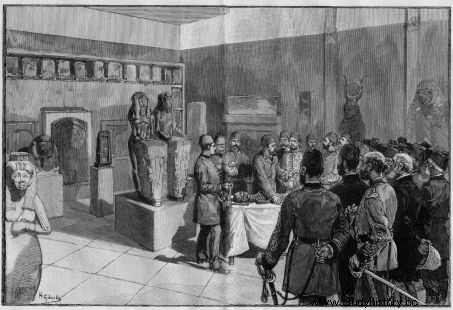The "screaming mummy", protagonist of a plot that led to the death of Pharaoh Ramses III during Antiquity, is exhibited for the first time at the Cairo Museum, in Egypt.

"The Screaming Mummy", or the "Unknown E", presumed mummy of Prince Pentaour, Egypt (XX th dynasty).
One of the victims of the famous "Harem Conspiracy"?... With its twisted mouth, the stigma of unspeakable pain, the mysterious mummy baptized "the Unknown E or "The Screaming Mummy “, is currently presented for the first time to the general public in a showcase of the Egyptian Museum in Tahir Square, Cairo (Egypt). A thick mystery has surrounded for decades this remains whose facial expression seems to stifle a terrible cry for 3000 years, as recalled by the online daily International Business Times (IBT) dated February 12, 2018.
Its discovery dates back to June 1886, when the Frenchman Gaston Maspero, then head of the Egyptian Antiquities Service, unwrapped several royal mummies found in Deir el Bahari in 1881, in a cache in the Valley of the Kings, on the left bank of the Nile ( read box ). The archaeologist was then surprised to discover in an anonymous coffin the mummy of a young man aged 18 to 20 whose feet and fists bore traces of ties. His parchment-like face seemed contorted by a horrible cry... Another subject of astonishment for the scientist:the mummy had been found covered with a sheepskin, a ritually impure object for the ancient Egyptians.
What had they wanted to punish this stranger for? Who could this young man be? What heinous act had he done to deserve such an infamous end? Some scientists mentioned poisoning, others… that he had been buried alive. Very quickly, the researchers identified this desiccated body as, probably, that of Pentaour, the son of Ramses III (1182-1151 before our era), pharaoh of the XX dynasty, and of Tiyi, one of his secondary wives. These family links were subsequently confirmed by genetic analyzes carried out in 2010 by Albert Zink, of the European Academy of Bolzano (Italy).
Professor Gaston Maspero unwrapping a mummy at the Boulak Museum in Cairo (Egypt), in 1886. © Leemage/AFP
To establish the identity of the mysterious mummy, the researchers had referred to ancient documents concerning the end of Ramses III, among which the "judiciary" of Turin*, or the papyrii Lee and Rollin. Linked to the famous "Harem Conspiracy" case, all described the "great abominations and the "abuses that had been done ". What was it ? Quite simply from a trivial and nevertheless dramatic affair of succession, one of those which tear apart the most famous families... According to the texts, Tiyi would have liked to place his son Pentaour on the throne, while Ramses III's choice was his fifth son , the royal scribe and general Ramses IV, born of his union with Queen Isis Tahemdjert.
Representation of Pharaoh Ramses III (XXth dynasty), in the temple of Medinet habou (Egypt). ©Antoine Lorgnier/AFP
The conspiracy having taken place within the royal harem, this name was given to the cabal. Tiyi had indeed succeeded in rallying to his cause various high-ranking figures, in particular generals, scribes, harem inspectors and "six wives of the men of the harem gate », or wives of guards. Not to mention the external rebels.
But the plot was a failure despite - a priori - the assassination of the pharaoh:analyzes and tomographic examinations carried out on the mummy of Ramses III in 2012 indeed revealed a serious wound in the throat, indicating that he had probably been killed . The conspirators, discovered, were arrested and a commission received full powers to judge the affair. Terrible sentences then fell on the seditious, including suicide live in front of the court (read box ). Prince Pentaour was also condemned to death.
According to Dr. Bob Brier interviewed in the IBT , archaeologist at Long Island University (New York) who examined the body of "The Unknown E on several occasions, this one was undoubtedly treated separately:“We can detect two contradictory attitudes towards this body. On the one hand, a desire to eliminate the body, and a concern for preservation on the other ". Even covered in the infamous sheepskin intended to rob him of any hope of access to the afterlife, someone has indeed, 3000 years ago, ensured that the prince remains within the royal family.
Until its recent presentation at the Cairo Museum, the mummy of "The Individual E was kept in storage, out of sight. Its public exposure time has not been specified.
Four trials for a conspiracy
Several trials have taken place regarding the "harem conspiracy" case. During the first of them, Tiyi, one of the wives of Pharaoh Ramses III and mother of Pentaour, was sentenced to death, and twenty-eight people involved in the plot undoubtedly suffered the same fate. During the second trial, six people had to commit suicide live in court. The Egyptians believed that high-ranking characters were more likely to be able to take revenge from the afterlife. By forcing them to commit suicide, they thought they were thus removing the threat. In a third trial, the same sentence was applied to four other people, including Prince Pentaour. As for the fourth trial, the victims are no longer the conspirators, but judges and guards accused of corruption. Their noses and ears were cut off.
The cache of Deir el Bahari
In 1881, Gaston Maspero, then director of Egyptian Antiquities, discovered more than 50 mummies of pharaohs gathered in a tomb composed of three chambers. Dug into the Theban mountain of Deir el-Bahari, above the temples, this vault was used to hide the royal mummies from the end of the so-called "ramesside" period, after 1069 BC. Priests would have liked to preserve them from the looting of the royal tombs which then prevailed. They remained there in secret for more than 3000 years.
Find out more :"Cases and scandals under the Ramesses », Pascal Vernus, Edition Pygmalion, 2009.


